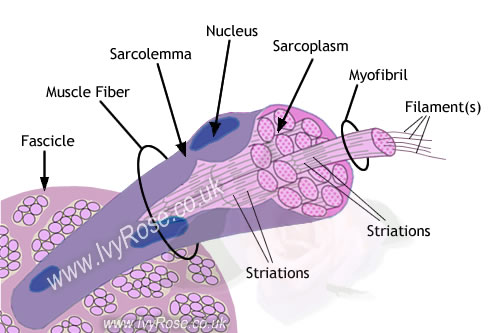
Muscle Fibre
Muscle Fibre (or muscle fiber, Am.Sp.) is a term that is often used interchangeably with muscle cell.
Muscle fibres are multinucleate, which means that they have many nuclei - see diagram below. Muscle fibres also have many myofibrils. There are hundreds of myofibrils in each muscle fibre.

Above: Simple diagram of the structure of a muscle fibre

Muscle fibres are the basic functional units of muscle tissue - which is special because it has the ability to contract, producing movement or force.
There are three main types of muscle tissue.
They are:
- Skeletal Muscle - muscles that move bones, under conscious control.
- Smooth Muscle - surrounding organs and other body structures, not under conscious control.
- Cardiac Muscle - the specialized muscle found only in the heart.
Muscle fibres are common to all of these.
This section consists of short summaries about the
structures that form the muscles of the body.
This list is not exhaustive but is intended to be appropriate for students
of A-Level Human Biology, ITEC courses in massage and related subjects,
and other courses in health sciences. For more general information about muscles see
the pages about:












